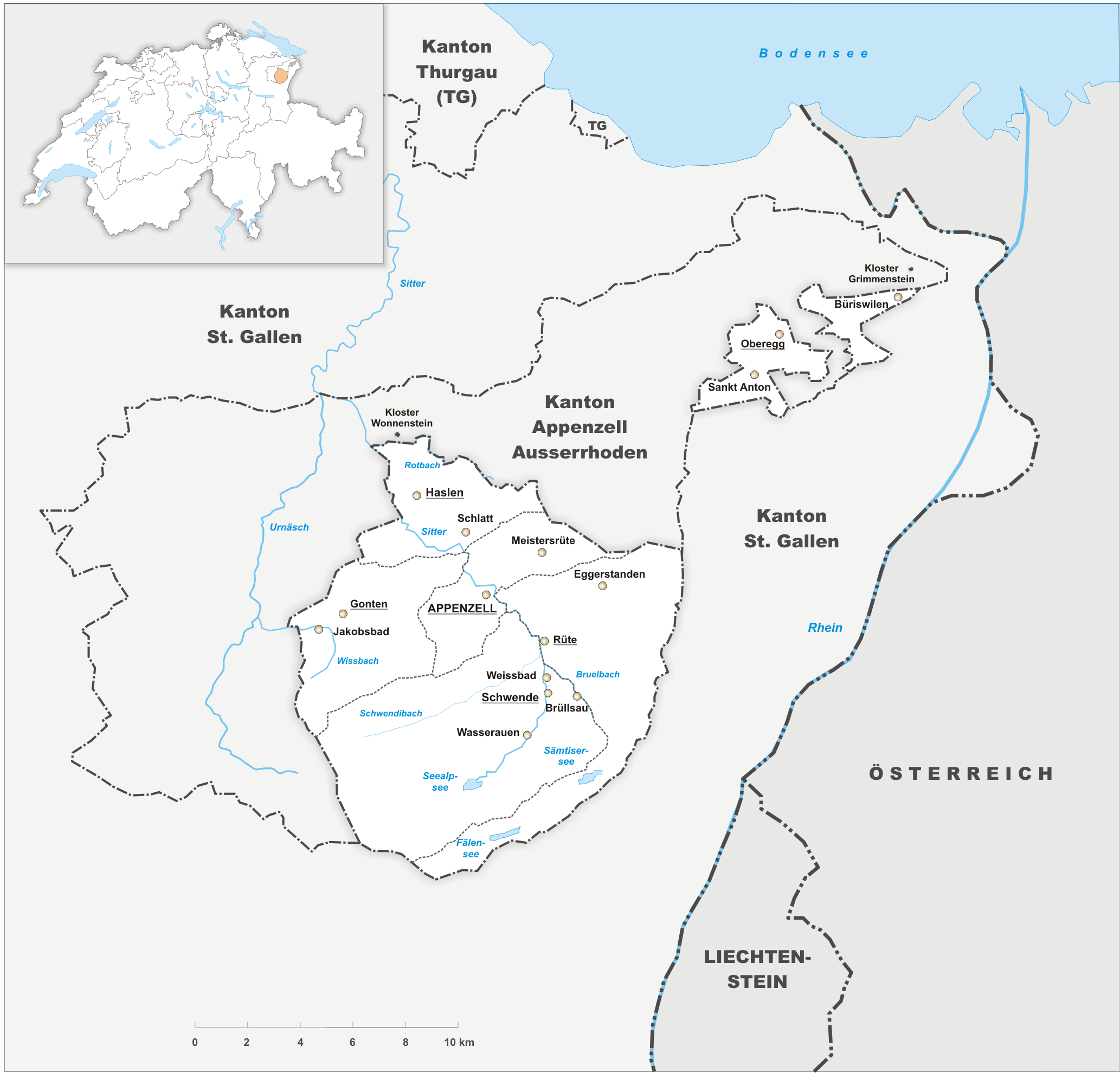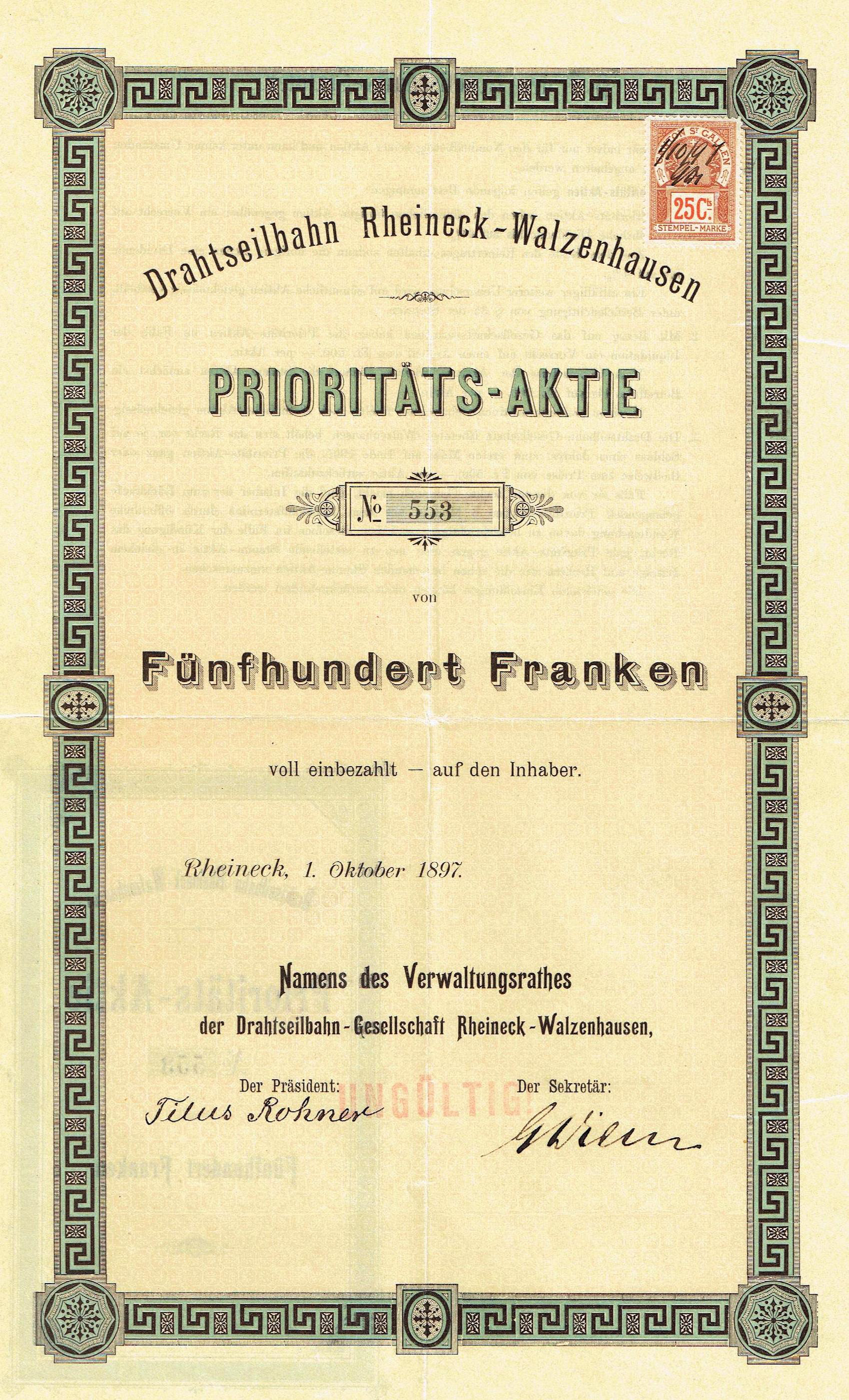|
Walzenhausen, Switzerland
Walzenhausen is a municipality in the canton of Appenzell Ausserrhoden in Switzerland. History The farm ''Walzenhausen'' was mentioned first in 1320. The church was built in 1638 in as little as nine months. This was the establishment of Walzenhausen as a municipality. In the past textiles played an important role, but today tourism has taken this role. This is facilitated by good public transport links. Geography Walzenhausen has an area, , of . Of this area, 52.4% is used for agricultural purposes, while 34.4% is forested. The rest of the land, (13.1%) is settled. Walzenhausen is the easternmost village in the canton Appenzell Ausserrhoden. It lies at and offers a panorama of Lake Constance below. Grimmenstein monastery is a small exclave of the canton of Appenzell Innerrhoden within the municipality. During the Protestant Reformation Walzenhausen adopted the new faith, while the monastery remained catholic. After centuries of debate and conflict over the monastery ... [...More Info...] [...Related Items...] OR: [Wikipedia] [Google] [Baidu] |
Appenzell Innerrhoden
Appenzell Innerrhoden (; in English sometimes Appenzell Inner-Rhodes) (german: Kanton Appenzell Innerrhoden rm, Chantun Appenzell Dadens; french: Canton d'Appenzell Rhodes-Intérieures; it, Canton Appenzello Interno) is one of the 26 cantons forming the Swiss Confederation. It is composed of six districts. The seat of the government and parliament is Appenzell. It is traditionally considered a " half-canton", the other half being Appenzell Ausserrhoden. Appenzell Innerrhoden is the smallest canton of Switzerland by population and the second smallest by area. It is located in the north east of the country. Together with the canton of Appenzell Ausserrhoden, it forms an enclave within the canton of St. Gallen. The canton is essentially located in the Alpine foothills of the Alpstein massif, culminating at the Säntis. Appenzell Innerrhoden was part of the historical canton of Appenzell, which was divided into Appenzell Ausserrhoden (Protestant) and Appenzell Innerrhoden (Ca ... [...More Info...] [...Related Items...] OR: [Wikipedia] [Google] [Baidu] |
Tertiary Sector Of The Economy
The tertiary sector of the economy, generally known as the service sector, is the third of the three economic sectors in the three-sector model (also known as the economic cycle). The others are the primary sector (raw materials) and the secondary sector (manufacturing). The tertiary sector consists of the provision of Service (economics), services instead of Product (business), end products. Services (also known as "Intangible good, intangible goods") include attention, advice, access, experience and affective labor. The information economy, production of information has been long regarded as a service, but some economists now attribute it to a fourth sector, called the quaternary sector. The tertiary sector involves the provision of services to other businesses as well as to final consumers. Services may involve the transport, distribution (economics), distribution and sale of goods from a producer to a consumer, as may happen in wholesaler, wholesaling and retailer, retaili ... [...More Info...] [...Related Items...] OR: [Wikipedia] [Google] [Baidu] |
Secondary Sector Of The Economy
In macroeconomics, the secondary sector of the economy is an economic sector in the three-sector theory that describes the role of manufacturing. It encompasses industries that produce a finished, usable product or are involved in construction. This sector generally takes the output of the primary sector (i.e. raw materials) and creates finished goods suitable for sale to domestic businesses or consumers and for export (via distribution through the tertiary sector). Many of these industries consume large quantities of energy, require factories and use machinery; they are often classified as light or heavy based on such quantities. This also produces waste materials and waste heat that may cause environmental problems or pollution (see negative externalities). Examples include textile production, car manufacturing, and handicraft. Manufacturing is an important activity in promoting economic growth and development. Nations that export manufactured products tend to generate highe ... [...More Info...] [...Related Items...] OR: [Wikipedia] [Google] [Baidu] |
Primary Sector Of The Economy
The primary sector of the economy includes any industry involved in the extraction and production of raw materials, such as farming, logging, fishing, forestry and mining. The primary sector tends to make up a larger portion of the economy in developing countries than it does in developed countries. For example, in 2018, agriculture, forestry, and fishing comprised more than 15% of GDP in sub-Saharan Africa but less than 1% of GDP in North America. In developed countries the primary sector has become more technologically advanced, enabling for example the mechanization of farming, as compared with lower-tech methods in poorer countries. More developed economies may invest additional capital in primary means of production: for example, in the United States corn belt, combine harvesters pick the corn, and sprayers spray large amounts of insecticides, herbicides and fungicides, producing a higher yield than is possible using less capital-intensive techniques. These technologic ... [...More Info...] [...Related Items...] OR: [Wikipedia] [Google] [Baidu] |
Fachhochschule
A ''Fachhochschule'' (; plural ''Fachhochschulen''), abbreviated FH, is a university of applied sciences (UAS), in other words a German tertiary education institution that provides professional education in many applied sciences and applied arts, such as engineering, technology, business, architecture, design, and industrial design. ''Fachhochschulen'' were first founded in Germany and were later adopted in Austria, Liechtenstein, Switzerland, Cyprus, and Greece. An increasing number of ''Fachhochschulen'' are abbreviated as ''Hochschule'', the generic term in Germany for institutions awarding academic degrees in higher education, or expanded as ''Hochschule für angewandte Wissenschaften (HAW)'', the German translation of "universities of applied sciences", which are primarily designed with a focus on teaching professional skills. Swiss law calls ''Fachhochschulen'' and universities "separate but equal". Due to the Bologna process, universities and ''Fachhochschulen'' award l ... [...More Info...] [...Related Items...] OR: [Wikipedia] [Google] [Baidu] |
Education In Switzerland
The education system in Switzerland is very diverse, because the constitution of Switzerland delegates the authority for the school system mainly to the cantons. The Swiss constitution sets the foundations, namely that primary school is obligatory for every child and is free in state schools and that the confederation can run or support universities. The minimum age for primary school is about six years in all cantons but Obwalden, where it is five years and three months. After primary schools, the pupils split up according to their abilities and intentions of career paths. Roughly 25% of all students attend lower and upper secondary schools leading, normally after 12 school years in total to the federal recognized matura or an academic Baccalaureate which grants access to all universities. The other students split in two or more school-types, depending on the canton, differing in the balance between theoretical and practical education. It is obligatory for all children to atte ... [...More Info...] [...Related Items...] OR: [Wikipedia] [Google] [Baidu] |
Free Democratic Party Of Switzerland
french: Parti radical-démocratique it, Partito Liberale Radicale rm, Partida liberaldemocrata svizra , logo = Free Democratic Party of Switzerland logo French.png , logo_size = 200px , foundation = , dissolution = , merged = FDP.The Liberals , headquarters = Neuengasse 20 Postfach 6136CH-3001 Bern , ideology = , position = Centre-right , international = Liberal International , european = European Liberal Democrat and Reform Party , europarl = , colours = Azure , country = Switzerland The Free Democratic Party or Radical Democratic Party (german: Freisinnig-Demokratische Partei, FDP; french: Parti radical-démocratique, PRD; it, Partito liberale-radicale svizzero, PLR; rm, Partida liberaldemocrata svizra, PLD) was a liberal political party in Switzerland. Formerly one of the major parties in Switzerland, on 1 January 2009 it merged with the Liberal ... [...More Info...] [...Related Items...] OR: [Wikipedia] [Google] [Baidu] |
2007 Swiss Federal Election
Elections to the Swiss Federal Assembly, the federal parliament of Switzerland, were held on Sunday, 21 October 2007. In a few cantons, a second round of the elections to the Council of States was held on 11 November, 18 November, and 25 November 2007. For the 48th legislative term of the federal parliament (2007–2011), voters in 26 cantons elected all 200 members of the National Council as well as 43 out of 46 members of the Council of States. The other three members of the Council of States for that term of service were elected at an earlier date.The date of the election of the members of the Council of States is a matter of cantonal law. 24 cantons have chosen to let the elections coincide with the federally regulated National Council elections. Two cantons are electing their members of the Council of States at an earlier date: Zug reelected its incumbents Peter Bieri and Rolf Schweiger on 29 October 2006, while Appenzell Innerrhoden elected Ivo Bischofsberger as its on ... [...More Info...] [...Related Items...] OR: [Wikipedia] [Google] [Baidu] |
Heiden, Switzerland
Heiden is a village and a municipality in the canton of Appenzell Ausserrhoden in Switzerland. Its Biedermeier village around the church square is listed as a heritage site of national significance. History Heiden is first mentioned in 1461 as ''guot genant Haiden''. Heiden, Lutzenberg, and Wolfhalden originally were parts of a single municipality named the Kurzenberg. Around 1650, Heiden and Wolfhalden could not agree about control over the local church. This led to the creation of a separate church in each village in 1652, making them independent. In 1658 the Kurzenberg was split into the three separate municipalities in defiance of the canton government. Their borders were officially established in 1666-67. The founder of the Red Cross, Henry Dunant, spent his last years in Heiden. The former president of the ICRC, Jakob Kellenberger, was also born in Heiden. Geography Heiden has an area, , of . Of this area, 52.4% is used for agricultural purposes, while 30.6% is f ... [...More Info...] [...Related Items...] OR: [Wikipedia] [Google] [Baidu] |
Rheineck Railway Station
Rheineck railway station (german: Bahnhof Rheineck) is a railway station that serves the municipality of Rheineck, in the canton of St. Gallen, Switzerland. The station is located on the eastern edge of Rheineck village centre, with the A1 motorway, the Alter Rhein river channel and then the border with Austria flanking the opposite side of the station. The station is an intermediate stop on the St. Margrethen–Rorschach railway line, and is the lower terminus of the Rheineck–Walzenhausen mountain railway. It is served by St. Gallen S-Bahn services S2, S4, and S5, which link Rheineck to the city of St. Gallen and other local towns, and by service S26, which shuttles up to Walzenhausen. The S2, S4, and S5 each run hourly, providing three trains per hour to and from St. Gallen, whilst the S26 operates one or two return journeys per hour, depending on the time of day. Rheineck is also the easterly end of the Swiss shipping services on Lake Constance Lake Constance (ge ... [...More Info...] [...Related Items...] OR: [Wikipedia] [Google] [Baidu] |
Rheineck–Walzenhausen Mountain Railway
The Rheineck–Walzenhausen mountain railway (german: Bergbahn Rheineck–Walzenhausen; RhW) is a long rack railway in Switzerland. It links Rheineck station, in the municipality of Rheineck and the canton of St Gallen, with the village and health resort of Walzenhausen, in the canton of Appenzell Ausserrhoden. Passenger service on the line now forms part of the St. Gallen S-Bahn, branded as the S26. The line is owned and operated by the Appenzell Railways company, which also operates several other railway lines in the two Appenzell cantons. History The concession for the construction of a rail link between Rheineck and Walzenhausen was granted in 1889. The ''Drahtseilbahn-Gesellschaft Rheineck-Walzenhausen'' company started construction in 1895 and the line opened on 27 June 1896. As constructed, the line was a water operated funicular railway that linked the current upper station at Walzenhausen with a lower station at Ruderbach, some short of Rheineck station. In 1909, a ... [...More Info...] [...Related Items...] OR: [Wikipedia] [Google] [Baidu] |





